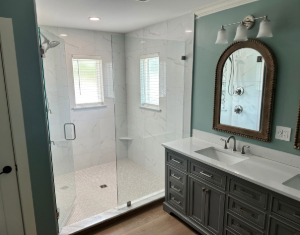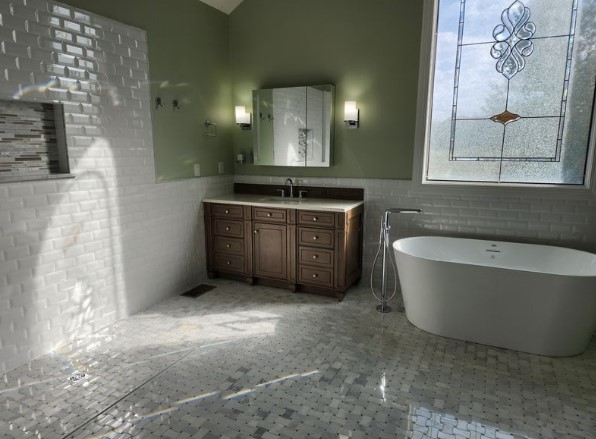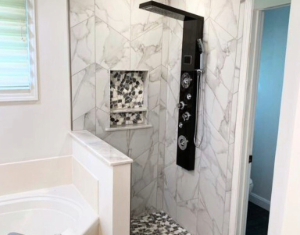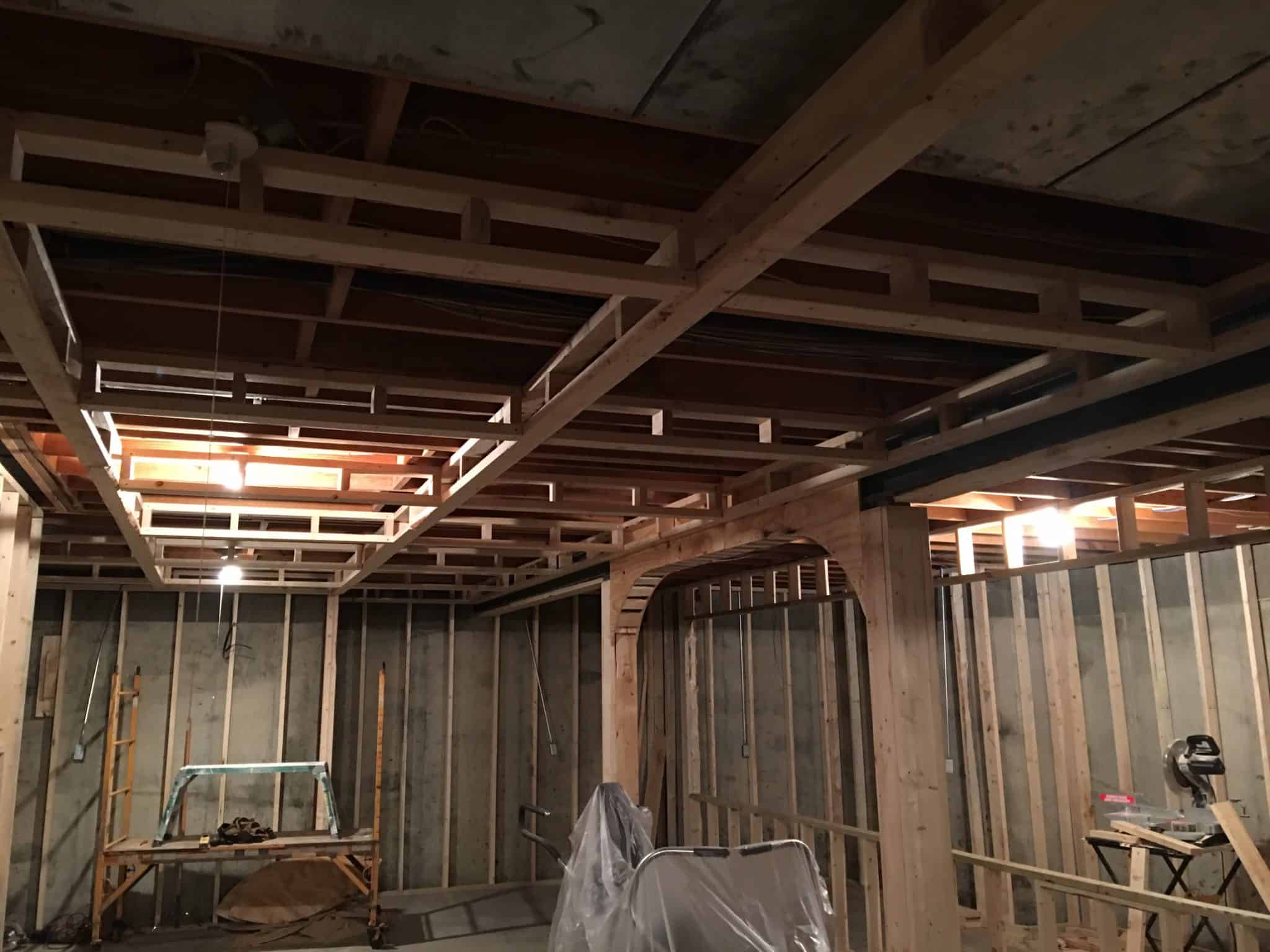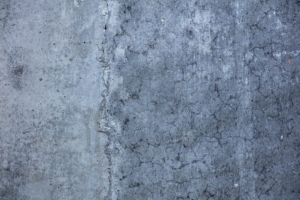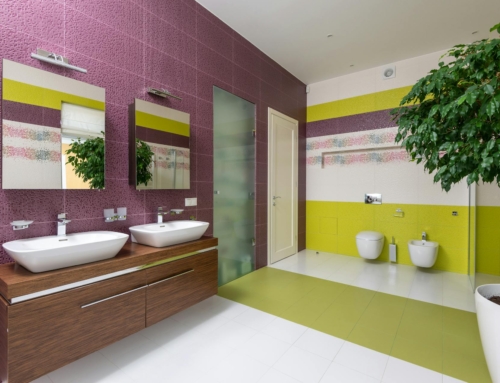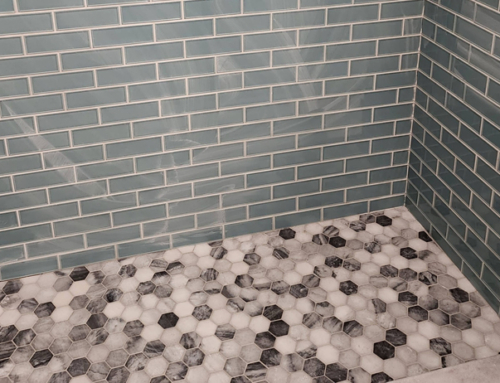Maximizing the space below your main floor can be an excellent two-fold investment: a basement renovation adds practical living space to your home, and can significantly increase your home’s property value. If you’re a homeowner who’s ready to clear out the cobwebs and out-of-season holiday decorations and create some new rooms in your boring concrete basement from the (under)ground up, we’ve got you covered. Here are some things to consider before finishing your basement.
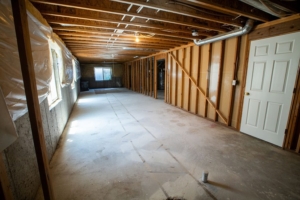
Photo by Real Twin Photos on Unsplash
This is one of those projects many homeowners think they may want to DIY, however taking into account all of the considerations below (possibly with a step-by-step checklist) may help inform a better decision to employ a professional like FlooringMasters.
Here are some factors that must be considered before putting any further work into the project. Several of these items should be checked even if you don’t plan a basement remodel in the near future.
Things to Consider Before Finishing Your Basement: Water
If your basement has any issues with water, it is important to have them addressed as soon as possible. Water can cause a lot of damage to your home, and it can also be a health hazard. If you have any questions about your basement or its waterproofing, please contact a professional. Mold and mildew issues will have to be addressed before any work can get started.
Can you spot any cracks in the foundation?
If you’re concerned about the structural integrity of your home, it’s important to look for cracks in the foundation. These cracks can be caused by a number of things, including settling, water damage, and poor construction. If you see any cracks, it’s important to have them evaluated by a professional to determine if they pose a threat to the stability of your home.
Things to Consider Before Finishing Your Basement: Radioactive Radon Gas
If you live in an area where this is a known problem, it’s a good idea to have your basement tested. Radon is a gas that can be found in the soil, and it can seep into your home through cracks in the foundation. If you have high levels of the gas in your home, it can be dangerous to your health. If you’re not sure, it’s worth getting your basement tested.
What’s the current wall situation?
Basement walls are all over the map in format and condition based on the age and prior construction of your home. You may even have masonry down there! Most modern basement projects will include adding or replacing existing drywall and possibly the construction of studs to add rooms or new foundation walls if needed. Adding new construction as opposed to refinishing may push you into the territory of needing building permits. We’ll be sure to check local building codes for considerations in the project.
How high is the basement ceiling?
Unless you enjoy crouching through door frames, height can be a deal-breaker. Additionally, many basements have electrical, plumbing and HVAC ductwork exposed overhead, so those should be taken into consideration during the design stage. These home systems will need to remain accessible in some places, and where they can be covered, there are design options available.
Drop ceilings are suspended from the structural ceiling and hang down to a lower level. They are often used in commercial buildings to create an acoustically sound environment, or to hide unwanted features such as pipes or wiring.
Suspended ceilings are made up of ceiling tiles that are hung from a metal grid system. The grid system is attached to the structural ceiling with hangers, and the panels fit into the grid. Suspended ceilings can be made from a variety of materials, including fabric, metal, wood, and plastic.
If you need to access the ceiling for maintenance or repairs, you will need to remove the panels. This can be done by removing the hangers that attach the panel to the grid, or by removing the entire panel. A finished ceiling will add significant visual appeal!
How about doors and windows?
If you’re lucky enough to have egress windows, then some natural light may already be coming into your below grade spaces and save on lighting needs. Doors will need to be in good condition and the right size to be usable for the rooms’ needs. The addition of doors can give your basement visual appeal by breaking up the space.
Is your current HVAC system capable of supporting additional living or entertainment space in the basement?
If you’re considering adding a basement to your home or doing a refinish, you’ll need to make sure that your current HVAC system is capable of supporting the additional living or entertainment space. Depending on the size of the space and the climate in your area, you may need to upgrade your existing system or install a new one and have your current duct setup reviewed for comfort. Speak with a qualified HVAC ventilation contractor to determine what’s necessary to keep your basement comfortable year-round. If your HVAC system isn’t built to accommodate the extra square-footage of your basement, you may want to consider an upgrade.
Photo by Drew Beamer on Unsplash
Do you plan to include any bathroom or kitchen facilities in the basement?
If so, we’ll need to locate your home’s main drain to determine whether it runs underground or above ground. If it’s underground, installing the new plumbing should be more or less the same as if it were upstairs. But if it runs above ground, we will need to install special equipment to pump water up and out, against the flow of gravity. Valves and controls will have to be easy to access.
Will any new basement rooms be used for recreation or entertainment purposes?
The basement can be the perfect space to create play areas for kids, wet bars for mom and dad, or even your own private movie theater for the whole family. But noise from the basement can be a serious issue upstairs if the ceiling isn’t properly insulated for sound.
How about the flooring?
Much like your bathrooms upstairs, you’ll want to pick out a basement floor material that’s made to be exposed to water, like porcelain tile. Even the most well-protected basements may be subjected to water damage over a lifetime, so go with flooring that won’t need to be replaced if and when that happens. Trust us: your future self will thank you. Your floors and walls are one of the most significant factors in the basement remodel and can have a big impact on the materials required for the project.
The condition of your main floor joists will also need to be evaluated to make sure they are strong enough and not weakened by insects or dry rot. These components may need to be strengthened or replaced with new ones.
Speaking of insulation
Did you know that insulating your basement can lead to significant savings on your monthly energy bill? In fact, International Residential Code now requires new houses to have insulated basements in colder climates. It just makes good financial sense to insulate your basement interior, especially if your home doesn’t have insulation on the exterior of the foundation. If your project happens to include drywall additions or updates, then adding fiberglass or polystyrene foam insulation just makes perfect sense while we’re in there!
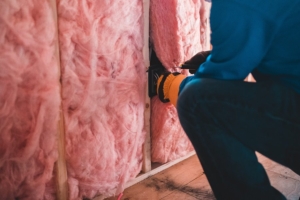
Photo by Erik Mclean: https://www.pexels.com/photo/unrecognizable-worker-insulating-with-stone-wool-6124239/
How Much Does it Cost to Finish A Basement?
This is a very common Google search, and quite possibly how you ended up reading this article, and unfortunately you probably already know the answer. This is a significant home improvement project and the current construction or condition of your basement (is it unfinished or just outdated? do we need to replace or just finish the walls and ceiling? What condition are the ceiling joists in?) coupled with your vision of the finished basement floor plan will help inform the total project cost.
But here’s a general idea: the cost to finish a basement can vary depending on the size of the space, the materials used, and the level of finish desired. However, on average, it is estimated that creating a beautiful new space that can be used will cost between $10,000 and $25,000.
Home improvement projects can add significant value to your home, and finishing the basement is one of the best Return on Investment projects you can consider. Not to mention it’s a great way to add tremendous quality time and functionality (such as with a new laundry room) to a large area of your home that’s likely sitting idle. Once your basement is finished and your family starts enjoying this previously neglected home space, you’ll be glad you did it.
Conclusion
There are lots of other questions that will need to be addressed when finishing your basement, but if you’ve made it this far, you’re on the right track! Luckily for you, Flooring Masters & Professional Remodelers can handle every aspect of your basement finishing project, whether you plan for a new rec room or craft room, need some extra space or are just tired of living with that musty basement and it’s hard, concrete floor, let us help you take that dusty old storage space and turn it into something you and your family will cherish for the lifetime of the home. Call us today!


